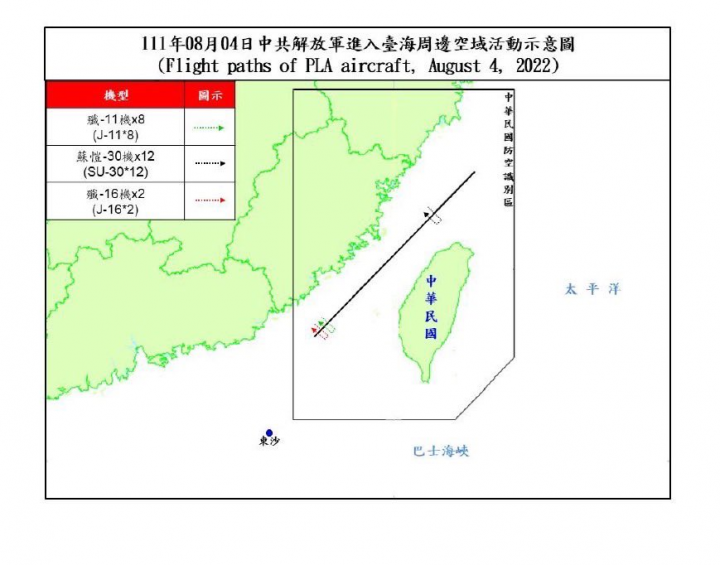
Taipei, Aug. 4 (CNA) China's ongoing live-fire drills around Taiwan could provide insights into how to meet future threats from the People's Liberation Army (PLA), experts said Thursday at a forum in Taipei.
Following a visit to Taiwan by U.S. House Speaker Nancy Pelosi from Tuesday to Wednesday, Taiwanese pro-democracy activist Yang Chih-yuan (楊智淵) was detained in China, Taiwan Thinktank consultant Tung Li-wen (董立文) told the audience at a forum about Pelosi's visit and its immediate repercussions in the Taiwan Strait.
Also, a Chinese drone was flown by Taiwan's outlying Kinmen County, Dongfeng missiles were fired by the PLA into waters off Taiwan, and multiple PLA aircraft breached the Taiwan Strait median line, he added.
This demonstrates that it is not a question of "if" China would militarily invade Taiwan, but "when" and "how" it would do so, Tung said, adding that Taipei and Washington should observe the live-fire drills, which started Thursday and are set to last until Sunday, Aug. 7, and use them as a guide to formulate a strategy for future Chinese aggression.
The drills' six maritime zones designated by the PLA around Taiwan have revealed the basic configuration of a possible future military invasion by China, said Ma Chen-kun (馬振坤), director of the Graduate Institute of China Military Affairs Studies at National Defense University.
However, whether the PLA could achieve the results it had hoped for when it orchestrated the current blockade drills -- for example, suppressing the Republic of China (ROC, Taiwan's official name) armed forces in the early stages of their combat preparations -- will depend on what maneuvers it adopts during the drills in the coming days, Ma said.
Despite the ROC's air and sea defense capabilities acting as a deterrence to the PLA, the drills will fundamentally eliminate a tacit agreement between the two sides, which is that the Taiwan Strait median line should not be breached, he said.
Taiwan should expect a vastly increased number of incidents in which the PLA crosses the strait's median line in the future, which will mean the ROC forces will have less room to mount air or sea defenses, making their jobs even more challenging, he said.
Taiwan should not just focus on developing asymmetrical defense capabilities, but should also maintain a reasonably sized military, effective air and sea deterrence, and beyond-visual-range striking capabilities, which are all necessary to help Taiwan counter blockades, he said.
Separately on Thursday, former ROC Navy lieutenant commander Lu Li-shih (呂禮詩) said the PLA could fire missiles across Taiwan into a maritime zone off the nation's eastern coast which it had demarcated as a location for the live-fire drills.
The point of doing so would be to rattle Taiwanese by triggering Taiwan's cell broadcast system, so that people will receive missile alerts, Lu said in a Facebook post.
Lu noted that the six "carefully placed" zones encircling Taiwan did not fit the Max Planck Encyclopedia of Public International Law's definition of a blockade, but were more likely positioned with the intention of demonstrating the PLA's firepower.